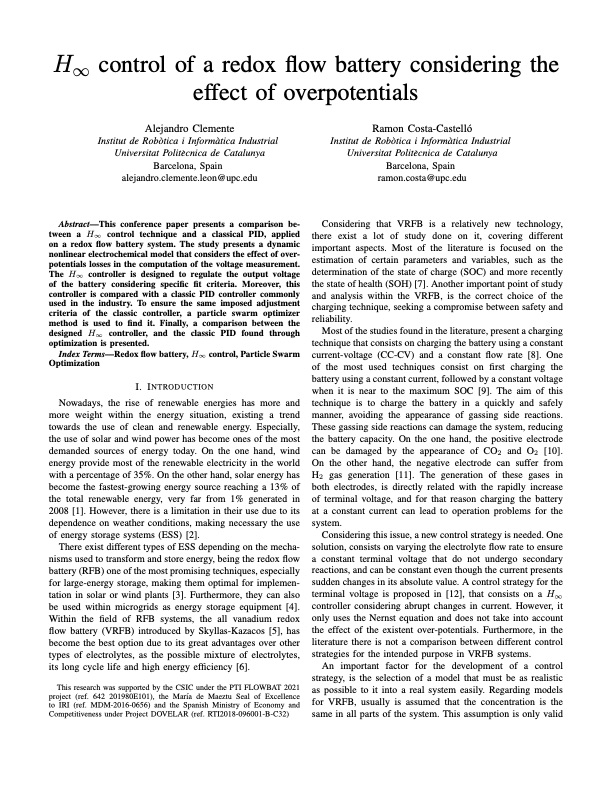
PDF Publication Title:
Text from PDF Page: 001
H∞ control of a redox flow battery considering the effect of overpotentials Alejandro Clemente Institut de Robo`tica i Informa`tica Industrial Universitat Polite`cnica de Catalunya Barcelona, Spain alejandro.clemente.leon@upc.edu Abstract—This conference paper presents a comparison be- tween a H∞ control technique and a classical PID, applied on a redox flow battery system. The study presents a dynamic nonlinear electrochemical model that considers the effect of over- potentials losses in the computation of the voltage measurement. The H∞ controller is designed to regulate the output voltage of the battery considering specific fit criteria. Moreover, this controller is compared with a classic PID controller commonly used in the industry. To ensure the same imposed adjustment criteria of the classic controller, a particle swarm optimizer method is used to find it. Finally, a comparison between the designed H∞ controller, and the classic PID found through optimization is presented. Index Terms—Redox flow battery, H∞ control, Particle Swarm Optimization I. INTRODUCTION Nowadays, the rise of renewable energies has more and more weight within the energy situation, existing a trend towards the use of clean and renewable energy. Especially, the use of solar and wind power has become ones of the most demanded sources of energy today. On the one hand, wind energy provide most of the renewable electricity in the world with a percentage of 35%. On the other hand, solar energy has become the fastest-growing energy source reaching a 13% of the total renewable energy, very far from 1% generated in 2008 [1]. However, there is a limitation in their use due to its dependence on weather conditions, making necessary the use of energy storage systems (ESS) [2]. There exist different types of ESS depending on the mecha- nisms used to transform and store energy, being the redox flow battery (RFB) one of the most promising techniques, especially for large-energy storage, making them optimal for implemen- tation in solar or wind plants [3]. Furthermore, they can also be used within microgrids as energy storage equipment [4]. Within the field of RFB systems, the all vanadium redox flow battery (VRFB) introduced by Skyllas-Kazacos [5], has become the best option due to its great advantages over other types of electrolytes, as the possible mixture of electrolytes, its long cycle life and high energy efficiency [6]. This research was supported by the CSIC under the PTI FLOWBAT 2021 project (ref. 642 201980E101), the Mar ́ıa de Maeztu Seal of Excellence to IRI (ref. MDM-2016-0656) and the Spanish Ministry of Economy and Competitiveness under Project DOVELAR (ref. RTI2018-096001-B-C32) Ramon Costa-Castello ́ Institut de Robo`tica i Informa`tica Industrial Universitat Polite`cnica de Catalunya Barcelona, Spain ramon.costa@upc.edu Considering that VRFB is a relatively new technology, there exist a lot of study done on it, covering different important aspects. Most of the literature is focused on the estimation of certain parameters and variables, such as the determination of the state of charge (SOC) and more recently the state of health (SOH) [7]. Another important point of study and analysis within the VRFB, is the correct choice of the charging technique, seeking a compromise between safety and reliability. Most of the studies found in the literature, present a charging technique that consists on charging the battery using a constant current-voltage (CC-CV) and a constant flow rate [8]. One of the most used techniques consist on first charging the battery using a constant current, followed by a constant voltage when it is near to the maximum SOC [9]. The aim of this technique is to charge the battery in a quickly and safely manner, avoiding the appearance of gassing side reactions. These gassing side reactions can damage the system, reducing the battery capacity. On the one hand, the positive electrode can be damaged by the appearance of CO2 and O2 [10]. On the other hand, the negative electrode can suffer from H2 gas generation [11]. The generation of these gases in both electrodes, is directly related with the rapidly increase of terminal voltage, and for that reason charging the battery at a constant current can lead to operation problems for the system. Considering this issue, a new control strategy is needed. One solution, consists on varying the electrolyte flow rate to ensure a constant terminal voltage that do not undergo secondary reactions, and can be constant even though the current presents sudden changes in its absolute value. A control strategy for the terminal voltage is proposed in [12], that consists on a H∞ controller considering abrupt changes in current. However, it only uses the Nernst equation and does not take into account the effect of the existent over-potentials. Furthermore, in the literature there is not a comparison between different control strategies for the intended purpose in VRFB systems. An important factor for the development of a control strategy, is the selection of a model that must be as realistic as possible to it into a real system easily. Regarding models for VRFB, usually is assumed that the concentration is the same in all parts of the system. This assumption is only validPDF Image | H control of a redox flow battery overpotentials

PDF Search Title:
H control of a redox flow battery overpotentialsOriginal File Name Searched:
2523-Flow-controlling-tuning-for-the-voltage-flow-battery.pdfDIY PDF Search: Google It | Yahoo | Bing
Salgenx Redox Flow Battery Technology: Salt water flow battery technology with low cost and great energy density that can be used for power storage and thermal storage. Let us de-risk your production using our license. Our aqueous flow battery is less cost than Tesla Megapack and available faster. Redox flow battery. No membrane needed like with Vanadium, or Bromine. Salgenx flow battery
| CONTACT TEL: 608-238-6001 Email: greg@salgenx.com | RSS | AMP |